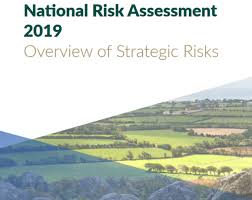On 5 August, Bank Holiday Monday, the Government published The National Risk Assessment, 2019: Overview of Strategic Risks. This is a 92-page document that sets out various risks facing Ireland, under five headings. The first such report was produced in 2014.
This report was produced after a public consultation. There were more than 650 submissions, of which about 640 came from private individuals. There is no information about whether the private individuals were members of lobbying groups or political parties. The organisations that made submissions ranged from the IFA, ICMSA and ICTU to Birdwatch Ireland.
The report is quite comprehensive and offers the Government an opportunity to plan ahead. Unfortunately it does not give any indication of how the risks will be addressed. Given that a no-deal Brexit is deemed to be one of the main risks, and that the budget is due on 8 October, it is highly likely that the Government response will be made known at that time. The 2020 budget is expected to bring tax reductions and spending increases, but this would fly in the face of the National Risk Assessment.
The document’s five headings are sub-divided into five or six areas, so that there are twenty-seven sections in all. Strangely, the section on “Technological risks” includes sub-headings on nuclear contamination, major pandemics, and anti-microbial risks. I would have thought the section on “Environmental risks” would have been more appropriate.
This latter section includes a sub-section on “Biodiversity and climate change.” There is no mention of the impact our system of farming is having on the climate. In fact Brexit and climate changes are deemed the “external” threats. No mention of the use of land or rivers by farmers and capitalists in the pursuit of private profits.
This emphasises the Government’s problem, which is the the problem facing any bourgeois government in a capitalist society. There may well be awareness of the risks, but the ultimate decision-makers are individual capitalists pursuing profits for their own individual interests. In effect, individual capitalists dictate how a risk is addressed on an individual basis and not for the Government. The latter creates the economic and legal environments in which capitalism can function.
The last issue of Socialist Voice (and previous issues) addressed the question of social welfare pensions and the dependence ratio. The same themes are repeated here, with this exception: “the dependency ratio will increase into the future, in the absence of improbably large immigration of people of working age…”
The Government would seem to be unaware of the large numbers of people fleeing war zones or areas that have become uninhabitable. When the EU destroys fishing waters off Africa it seems reasonable that the people who have lost their livelihood should seek redress from the EU, either in compensation or in alternative means of living.
In other parts of the report immigration is recognised as taking place but not in the sense of population movement for economic reasons or to escape war zones. Although the population of the country has increased, it has scope for further increases through immigration.
Other areas of the report are much the same, in that risks are recognised but they are external. On housing in particular it is clear that the chaos of the market will decide on the provision of housing even though the population is increasing.
The Soviet Union planned ahead quite successfully throughout its existence. Despite coming into existence in a hostile environment, coming under attack from capitalist countries, and being forced to fight a civil war, it gradually overcame these hurdles to establish and consolidate the Revolution. The Soviet government then set about replacing the New Economic Policy by removing production for the market and replacing it with a system of production for society. Using this system of planning, the Soviet Union achieved extraordinary growth in the period up to 1970.
The level of growth was unsurpassed by any capitalist country in the same period. Once the market was eliminated the productive forces could be refocused to address specific risks, such as the Wall Street Crash and the fascist invasion of the Soviet Union.
The defeat of the fascists came at a great cost to the people of the Soviet Union, but growth was maintained, despite the enormous sacrifice. Unlike a capitalist country, the government of the Soviet Union was able to plan on the basis of the productive forces to hand. It was not dependent on the decisions of individual capitalists, who can distort economic policy in the pursuit of their own short-term gains.
An article by C. P. Chandrasekhar, “Learning to plan: Revisiting the Soviet experiment,” in Communist Review, summer 2019, analyses the success of the Soviet plans. In general this is a valuable report. It shows how limited a bourgeois government is in addressing risks. It is constrained by the fact that decisions are devolved to individual capitalists. Consequently, there is anarchy in the market, with oversupply, slumps, and waste.
The Soviet system of planning was highly successful up to the late 1960s. The fact that the Soviets were able to deal with the fascist invasion makes the risk from no-deal Brexit look fairly trivial. It was only when the Soviets reintroduced the market and private production that things began to fall apart.






